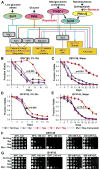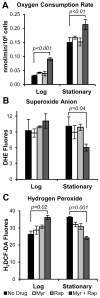Reducing signs of aging and increasing lifespan by drug synergy
- PMID: 23601176
- PMCID: PMC3714353
- DOI: 10.1111/acel.12090
Reducing signs of aging and increasing lifespan by drug synergy
Abstract
Disease incidence rises rapidly with age and increases both human suffering and economic hardship while shortening life. Advances in understanding the signaling pathways and cellular processes that influence aging support the possibility of reducing the incidence of age-related diseases and increasing lifespan by pharmacological intervention. Here, we demonstrate a novel pharmacological strategy that both reduces signs of aging in the budding yeast Saccharomyces cerevisiae and generates a synergistic increase in lifespan. By combining a low dose of rapamycin, to reduce activity of the target of rapamycin complex 1 (TORC1) protein kinase, and myriocin, to reduce sphingolipid synthesis, we show enhancement of autophagy, genomic stability, mitochondrial function, and AMP kinase pathway activity. These processes are controlled by evolutionarily conserved signal transduction pathways that are vital for maintaining a healthy state and promoting a long life. Thus, our data show that it ought to be possible to find pharmacological approaches to generate a synergistic reduction in the incidence of human age-related diseases to improve health quality in the elderly and enhance lifespan.
Keywords: S6 Kinase; TORC1; aging; autophagy; genomic stability; longevity.
© 2013 John Wiley & Sons Ltd and the Anatomical Society.
Figures




Similar articles
-
Caffeine extends yeast lifespan by targeting TORC1.Mol Microbiol. 2008 Jul;69(1):277-85. doi: 10.1111/j.1365-2958.2008.06292.x. Epub 2008 May 26. Mol Microbiol. 2008. PMID: 18513215
-
Uncharacterized yeast gene YBR238C, an effector of TORC1 signaling in a mitochondrial feedback loop, accelerates cellular aging via HAP4- and RMD9-dependent mechanisms.Elife. 2024 May 7;12:RP92178. doi: 10.7554/eLife.92178. Elife. 2024. PMID: 38713053 Free PMC article.
-
Down-regulating sphingolipid synthesis increases yeast lifespan.PLoS Genet. 2012 Feb;8(2):e1002493. doi: 10.1371/journal.pgen.1002493. Epub 2012 Feb 2. PLoS Genet. 2012. PMID: 22319457 Free PMC article.
-
The TORC1-Sch9 pathway as a crucial mediator of chronological lifespan in the yeast Saccharomyces cerevisiae.FEMS Yeast Res. 2018 Aug 1;18(5). doi: 10.1093/femsyr/foy048. FEMS Yeast Res. 2018. PMID: 29788208 Review.
-
Molecular mechanisms linking the evolutionary conserved TORC1-Sch9 nutrient signalling branch to lifespan regulation in Saccharomyces cerevisiae.FEMS Yeast Res. 2014 Feb;14(1):17-32. doi: 10.1111/1567-1364.12097. Epub 2013 Oct 11. FEMS Yeast Res. 2014. PMID: 24102693 Review.
Cited by
-
Tethering telomerase to telomeres increases genome instability and promotes chronological aging in yeast.Aging (Albany NY). 2016 Nov 13;8(11):2827-2847. doi: 10.18632/aging.101095. Aging (Albany NY). 2016. PMID: 27855118 Free PMC article.
-
Mitochondria to nucleus signaling and the role of ceramide in its integration into the suite of cell quality control processes during aging.Ageing Res Rev. 2015 Sep;23(Pt A):67-74. doi: 10.1016/j.arr.2014.12.007. Epub 2014 Dec 31. Ageing Res Rev. 2015. PMID: 25555678 Free PMC article. Review.
-
Alpha-Ketoglutarate: Physiological Functions and Applications.Biomol Ther (Seoul). 2016 Jan;24(1):1-8. doi: 10.4062/biomolther.2015.078. Epub 2016 Jan 1. Biomol Ther (Seoul). 2016. PMID: 26759695 Free PMC article. Review.
-
A scoping review regarding reproductive capacity modulation based on alpha-ketoglutarate supplementation.Reproduction. 2024 Oct 7;168(5):e240137. doi: 10.1530/REP-24-0137. Print 2024 Nov 1. Reproduction. 2024. PMID: 39189990 Free PMC article.
-
Aging is not programmed: genetic pseudo-program is a shadow of developmental growth.Cell Cycle. 2013 Dec 15;12(24):3736-42. doi: 10.4161/cc.27188. Epub 2013 Nov 15. Cell Cycle. 2013. PMID: 24240128 Free PMC article. Review.
References
Publication types
MeSH terms
Substances
Grants and funding
LinkOut - more resources
Full Text Sources
Other Literature Sources
Molecular Biology Databases
Miscellaneous

